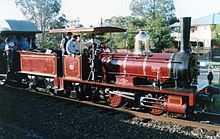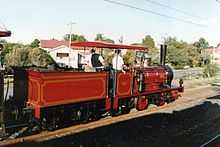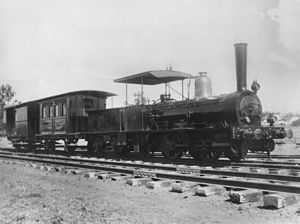Queensland A10 Neilson class locomotive
| Queensland A10 Neilson class locomotive | |
|---|---|
|
A.10 locomotive on display for the Railway Pageant at Ipswich, 1936. | |
| Type and origin | |
| Power type | Steam |
| Builder | Neilson and Company |
| Serial number | See numbering table |
| Build date | 1865-1866 |
| Total produced | 13 |
| Specifications | |
| Configuration | 0-4-2 |
| Gauge | 3 ft 6 in (1,067 mm) |
| Driver diameter | 36 in (914 mm) |
| Locomotive weight | 13.6 long tons (15.2 short tons; 13.8 t) |
| Tender weight | 9.35 long tons (10.5 short tons; 9.50 t) |
| Fuel type | Coal |
| Fuel capacity | 2.5 long tons (2.80 short tons; 2.54 t) |
| Water capacity | 560 imp gal (2,500 l; 670 US gal) |
| Boiler pressure | 120 lbf/in2 (827 kPa) |
| Cylinders | Two, outside |
| Cylinder size | 10 in × 18 in (254 mm × 457 mm) |
| Performance figures | |
| Tractive effort | 4,500 lbf (20.0 kN) |
| Career | |
| Operator(s) | Queensland Railways |
| Class | A10 |

The A10 Neilson class steam locomotive is a 0-4-2 locomotive of the Queensland Railways(QR).
The locomotives operated on 1,067 mm (3 ft 6 in) gauge. The “A”, is used to identify the number of coupled wheels, being four coupled wheels for the A10 class, followed by numerals indicating the cylinder diameter of ten inches (254 mm).

Overview
There were 12 locomotives bought by Queensland Government Railways. Eight were built for the Southern and Western Railway based on Ipswich and another four for the Central Railway at Rockhampton. One engine was also constructed for Peto, Brassey and Betts, a railway contractor building the line to Toowoomba. This was later purchased by the railway in 1876. These locomotives were built by Neilson and Company of Glasgow, Scotland between 1865 and 1866. All engines were fitted with injectors instead of feed pumps when built.
4D10 tank engine conversions
Four engines were converted to 4D10 tank engines, the “D”, is used to identify the locomotive as a tank engine, followed by numerals indicating the cylinder diameter of ten inches, the number “4” was used to denote the number of coupled wheels before the “D”.
The 20th century
Five engines survived the turn of the century although four of them were written off in 1902. N°3 continued in use shunting Bowen Jetty until 1914. It was then stored at Ipswich Workshops and restored to working order for the Railway Pageant in 1936. Afterwards it was preserved near Countess Street in Roma Street railway yard before being moved to Limestone Park at Ipswich in 1959.
Numbering
From: Queensland's Railways Interest Group[1]
| QR number | Works number | Year built |
|---|---|---|
| 4 | 1168 | 1865 |
| 5 | 1167 | 1865 |
| 6 | 1170 | 1865 |
| 7 | 1169 | 1865 |
| 8 | 1244 | 1866 |
| 9 | 1208 | 1866 |
| 10 | 1209 | 1866 |
| 11 | 1210 | 1866 |
| 12 | 1211 | 1866 |
| 13 | 1213 | 1866 |
| 14 | 1215 | 1866 |
| 2 | 1212 | 1866 |
| 3 | 1214 | 1866 |
Preservation
N°6 was sold to Gibson & Howes in 1896 for use on their Wattawa line. It was reboilered in 1955 and continued to serve the company until 1965 when it was presented to QR for Centenary Celebrations. The engine is retained in the Queensland Rail Heritage Fleet at Ipswich Workshops in working order and on display at the Workshops Rail Museum when not required for main line tours.[2]
See also
References
- ↑ http://www.qrig.org/motive-power/locomotives/steam/a10-neilson-originally-b-class
- ↑ http://www.theworkshops.qm.qld.gov.au/
External links
- http://www.qrig.org/motive-power/locomotives/steam/a10-neilson-originally-b-class
- http://www.qm.qld.gov.au/Learning+Resources/~/media/Documents/Learning%20resources/TWRM/Fact%20sheets/a10-no6-fs.pdf
| ||||||||||||||||||||||||||||||||||||||||||
